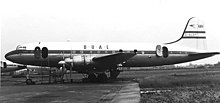Handley Page Hermes
Originally intended to enter service in advance of the Hastings, development of the Hermes was delayed by the fatal loss of the first prototype during its maiden flight on 2 December 1945.
Measures were taken to improve the airliner's stability as well as to expand its capacity, which sufficiently impressed the British Overseas Airways Corporation (BOAC) into placing a sizeable order for 25 HP 81 Hermes IV on 4 February 1947.
[1] At the time, authorities were considering not only the need for an immediate successor to the Royal Air Force's (RAF) fleet of Handley Page Halifax in the transport/freighter capacity, but also the role of an interim civil airliner for the post-war years.
Accordingly, during December 1944, priority orders were placed for various projects, including both the military and civil programmes proposed by the British aircraft manufacturer Handley Page.
[1] During April 1944, at the urging of George Volkert, Handley Page's chief designer, to settle production priorities, the company's founder and managing director Frederick Handley Page decided to merge the work of several projects and prioritise the transport aircraft; this also aligned with the release of Specification C.3/44, which sought a multipurpose transport.
[7] In order to sufficiently resolve the instability that caused the fatal crash, development of the civil Hermes was protracted, while work on the Hastings progressed more smoothly.
[8] This delay presented the opportunity to undertake design revisions and improvements; it was decided that the second prototype's length would be extended to produce the HP 74 Hermes II.
[9] The first Hermes II (G-AGUB) performed its first flight on 2 September 1947; it quickly proved to not only have greater stability, but to also possess a superior lift coefficient to the Hastings as well.
This model was furnished with a tricycle undercarriage and powered by four Bristol Hercules radial engines, each capable of generating up to 2,100 hp (1,570 kW).
[11] Despite the first Hermes IV (registered G-AKFP) performing its first flight relatively quickly on 5 September 1948,[4] and quantity production being promptly established, BOAC was somewhat unsatisfied by the airliner, primarily due to the early aircraft being overweight.
They were quickly replaced, however by the reliable Canadair Argonaut in 1952, although some re-entered service in July 1954 following the grounding of the de Havilland Comet, being retired again in December.





